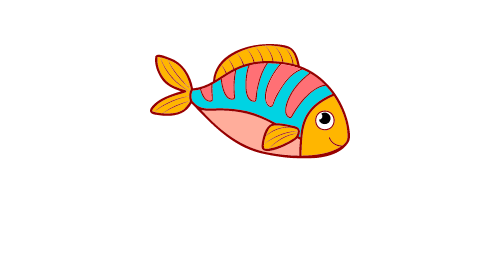Today, we’re taking a deep dive into the world of those mesmerizing underwater creatures that have captured hearts across generations – goldfish and their types! But hold onto your snorkels, because we’re about to uncover the lesser-known facets of these aquatic companions that will leave you wide-eyed and intrigued.
- A Glimpse into the History of Goldfish
- The Artistry of Color
- Types of Goldfish and its Caring Tips:
- Rethinking Goldfish Habitats
- Demystifying Goldfish Intelligence
- Goldfish in Cultural Chronicles
- In Summation: Plunging Beyond the Surface
A Glimpse into the History of Goldfish
Travel back with me to an era of flourishing dynasties and exquisite artistry – ancient China. It’s here that the captivating tale of goldfish first began, as innovative breeders embarked on a quest to transform wild carp into the dazzling beings we now know as goldfish. This extraordinary art of piscine transformation not only forged a connection with nature but also laid the groundwork for the mesmerizing aquatic pets we adore today.
The Artistry of Color
Imagine a chromatic symphony playing out within the scales of a goldfish. This living canvas is not just a product of chance but rather a masterpiece composed by genetics and human ingenuity. The intricate dance of genes and selective breeding gives rise to an array of hues that dance across their skin, ranging from the resplendent gold that lends them their name to a kaleidoscope of shades that mirror an artist’s palette. Speaking of names, you might want to read this article if you want to choose a name for your cute goldfish.
Types of Goldfish and its Caring Tips:
1. Common Goldfish:
The quintessential goldfish with its vibrant orange color and flowing fins. They’re social swimmers and can thrive in outdoor ponds.
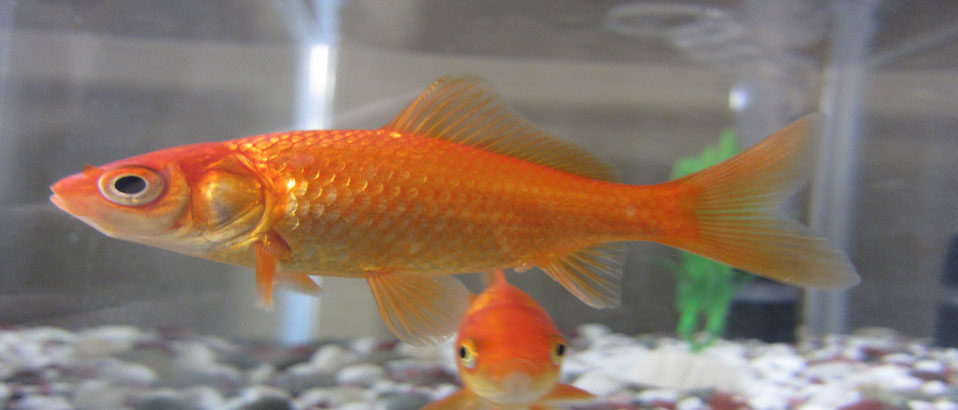
- Tank Size: Provide a spacious tank with at least 20 gallons of water per fish to accommodate their growth.
- Filtration: Invest in strong filtration to handle their waste production.
- Substrate: Opt for smooth, large-sized pebbles or a bare-bottom tank to prevent accidental ingestion.
- Temperature: Keep the water temperature between 65-72°F (18-22°C).
- Feeding: Feed a balanced diet of high-quality pellets or flakes a few times a day, watching for overfeeding.
| Type | Body Shape | Fin Type | Color Varieties | Size | Tank Size | Temperament | Lifespan | Care Level | Diet | Water Conditions |
|---|---|---|---|---|---|---|---|---|---|---|
| Common Goldfish | Streamlined | Single, paired fins and a straight tail fin | Orange, red, white, yellow, and combination | Up to 14 inches (35 cm) | Minimum 20 gallons for one, plus 10 gallons for each additional | Peaceful | 10-15 years | Easy | Omnivorous – flake, pellet, vegetables, and fruit | Cold water, 65-75°F (18-24°C), pH 6.0-8.0 |
2. Comet Goldfish:
Known for its long, trailing tail and graceful swimming. Its streamlined body is built for speed, making it a captivating sight.
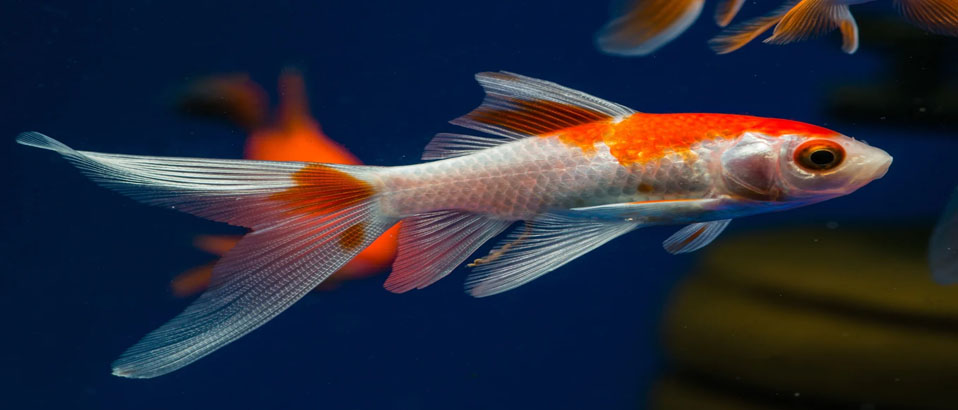
- Tank Size: Comets need ample space to swim; a pond or large tank is ideal.
- Filtration: Strong filtration is essential due to their active swimming and waste production.
- Temperature: Keep the water cooler, around 50-70°F (10-21°C).
- Feeding: Offer a varied diet that includes both pellets and live/frozen foods.
| Type | Body Shape | Fin Type | Color Varieties | Size | Tank Size | Temperament | Lifespan | Care Level | Diet | Water Conditions |
|---|---|---|---|---|---|---|---|---|---|---|
| Comet Goldfish | Streamlined with elongated body | Single, long, flowing tail fin | Red, orange, white, yellow, and combinations | Up to 12 inches (30 cm) | Minimum 30 gallons for one, plus 10-20 gallons for each additional | Active and social | 10-14 years | Easy | Omnivorous – flake, pellet, vegetables, and occasional live foods | Cold water, 60-70°F (16-21°C), pH 6.5-7.5 |
3. Shubunkin:
A unique breed with multicolored patterns resembling an impressionist painting. Their speckled appearance adds a touch of whimsy to any tank.
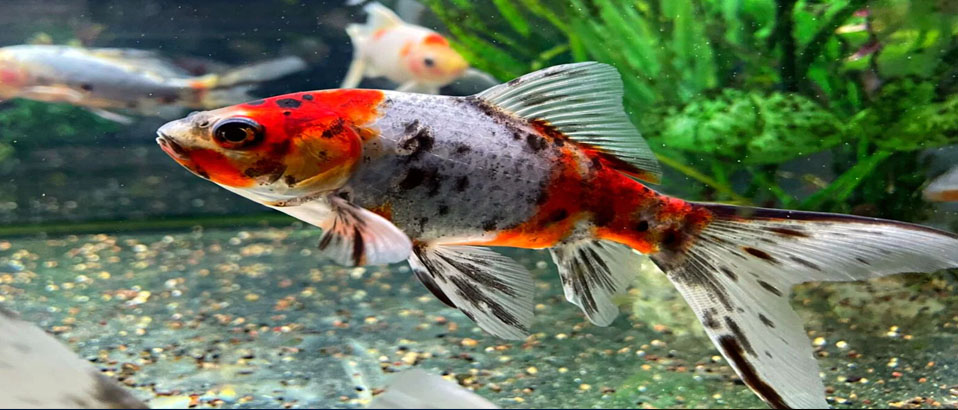
- Tank Size: Shubunkins necessitate generous room for their swimming activities, making a pond or sizeable tank the optimal choice.
- Filtration: Given their energetic swimming patterns and waste output, robust filtration becomes crucial.
- Temperature: Maintaining a cooler water environment, typically between 50-70°F (10-21°C), is advised.
- Feeding: Providing a diverse diet that encompasses both pellets and live/frozen foods ensures their nutritional needs are met.
| Type | Body Shape | Fin Type | Color Varieties | Size | Tank Size | Temperament | Lifespan | Care Level | Diet | Water Conditions |
|---|---|---|---|---|---|---|---|---|---|---|
| Shubunkin | Streamlined with elongated body | Single, long, flowing tail fin, similar to Comet | Calico, with mix of blue, red, orange, white, and black | Up to 14 inches (35 cm) | Minimum 40 gallons for one, plus 10-20 gallons for each additional | Active and hardy | 10-15 years | Easy | Omnivorous – enjoys a variety of foods including flakes, pellets, and live food | Cold water, 65-75°F (18-24°C), pH 6.5-7.5 |
4. Black Moor Goldfish:
The Black Moor goldfish is characterized by its unique appearance, featuring a velvety black coloration that covers its rounded and chubby body. It is known by several other names such as Black Peony goldfish and Dragon Eye goldfish. Its most iconic feature is its telescope eyes, which resemble bubbles and contribute to its distinctive allure. Despite reduced vision due to these eyes, Black Moor goldfish move gracefully and exhibit a peaceful and sociable nature. Their sensitivity to bright light calls for gentle lighting in their habitat. Overall, the Black Moor goldfish is a captivating aquatic gem that adds both visual intrigue and delightful companionship to aquariums.
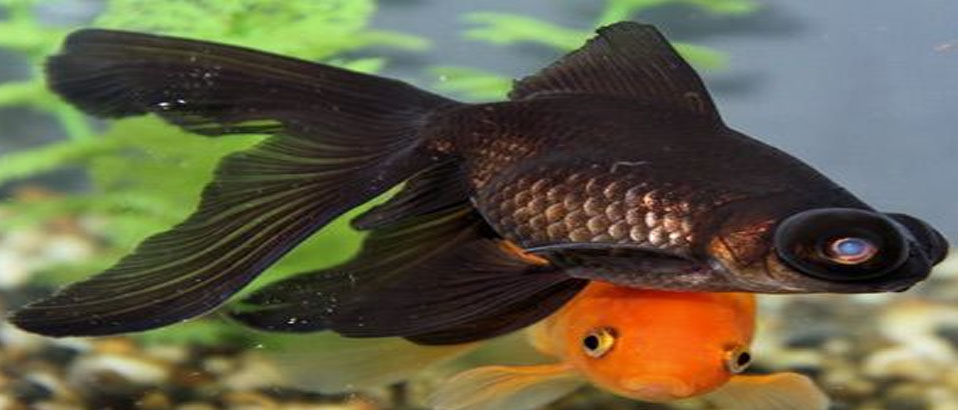
- Tank Setup: Provide hiding spots and low lighting to accommodate their sensitive eyes.
- Substrate: Use soft, sandy substrate to prevent damage to their delicate barbels.
- Temperature: Maintain a temperature range of 65-75°F (18-24°C).
- Feeding: Be cautious of overfeeding due to their slower digestion.
| Type | Body Shape | Fin Type | Color Varieties | Size | Tank Size | Temperament | Lifespan | Care Level | Diet | Water Conditions |
|---|---|---|---|---|---|---|---|---|---|---|
| Black Moor | Egg-shaped body | Long, flowing finnage | Velvety black | Up to 8 inches (20 cm) | Minimum 20 gallons for one, with an additional 10 gallons per fish | Peaceful | 5-10 years | Moderate due to vision impairment issues | Omnivorous – flakes, pellets, veggies, and live foods suited for poor eyesight | Cold water, 65-75°F (18-24°C), pH 6.5-7.5 |
5. Fantail Goldfish:
Recognized by its split tail and rounded body, often available in various colors. Their graceful movements are akin to underwater ballet.
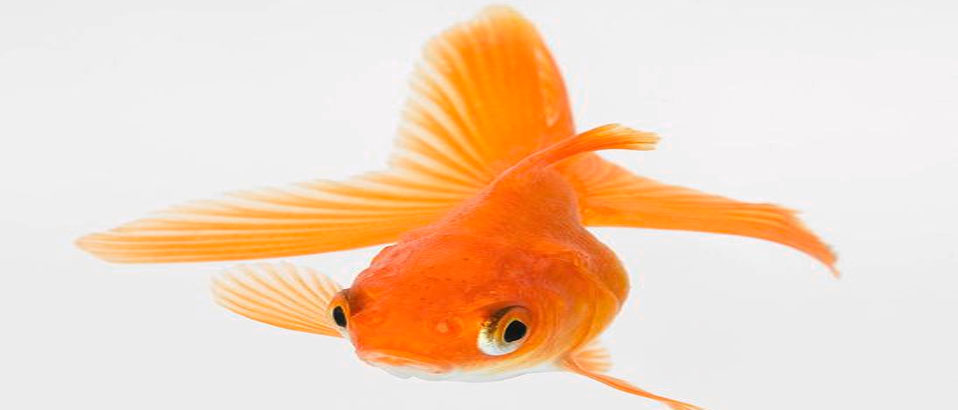
- Tank Size: Provide ample space, with a minimum of 20 gallons per fantail goldfish. Consider a larger tank for their growth and activity.
- Filtration: Ensure effective filtration to manage waste. Employ mechanical, biological, and chemical methods for water health.
- Temperature: Keep water between 65-75°F (18-24°C) and avoid sudden fluctuations. Shield from direct sunlight and drafts.
- Feeding: For fantail goldfish you should opt for high-quality goldfish-specific pellets or flakes. Include balanced spinach, peas, freeze-dried/frozen foods like bloodworms, daphnia, and brine shrimp. Feed small portions multiple times a day to prevent overfeeding.
| Type | Body Shape | Fin Type | Color Varieties | Size | Tank Size | Temperament | Lifespan | Care Level | Diet | Water Conditions |
|---|---|---|---|---|---|---|---|---|---|---|
| Fantail | Egg-shaped with high dorsal fin | Double caudal fin that fans out like a tail of a fancy dress | Orange, white, calico, and combinations thereof | Up to 8 inches (20 cm) | Minimum 20-30 gallons for one, with 10-20 gallons for each additional | Peaceful and social | 5-10 years | Easy, good for beginners | Omnivorous – pellets, vegetables, and suitable live foods | Cold water, 65-75°F (18-24°C), pH 6.5-7.5 |
6. Fancy Goldfish (Oranda, Ryukin, Ranchu, etc.):
Oranda Goldfish
The Oranda Goldfish is one of the most exquisite and popular varieties of fancy goldfish, admired for its unique “wen” or cap, which is a fleshy growth on the top of its head. This breed comes in a variety of colors, including red, black, blue, chocolate, and calico, making them a colorful addition to any aquarium. The Oranda’s body is rounded or egg-shaped, contributing to its charming appearance. These fish require specific care due to their delicate wen, which can be susceptible to infection if not kept in clean, well-maintained water. Orandas are known for their gentle nature and do well in a tank with other non-aggressive goldfish species.
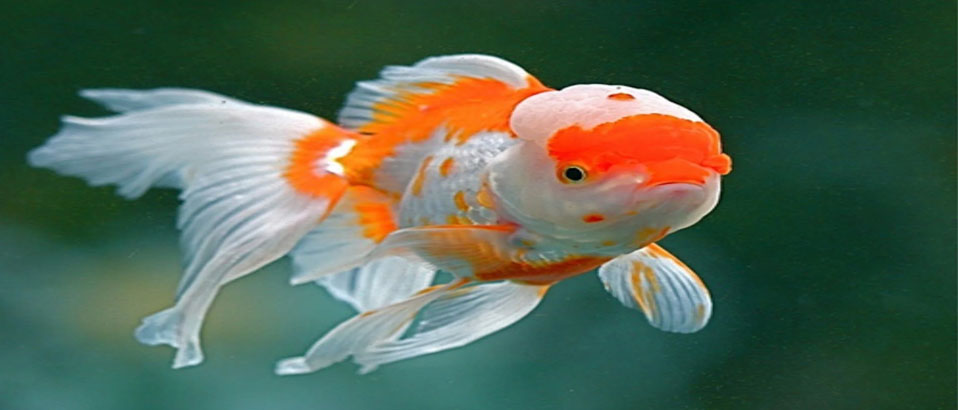
Breeding Oranda Goldfish
Breeding Oranda Goldfish is a process that should be approached with attention to detail, especially due to their sensitive wens. It’s crucial to provide a breeding environment that is meticulously clean to prevent infections. The breeding tank should have a temperature slightly warmer than their normal habitat, ideally around 70 to 75 degrees Fahrenheit, to stimulate spawning.
Breeders often use marbles or fine mesh at the bottom of the tank to protect the eggs from being eaten by adult fish. High-quality, varied diets are essential for conditioning the Orandas before breeding. The female will lay her eggs, which the male then fertilizes externally. Post-spawning, the adults should be separated from the eggs to ensure the eggs’ survival. The eggs generally hatch in about 4 to 6 days, and the fry should be fed with small, high-protein foods such as infusoria or liquid fry food, progressing to finely crushed flakes as they grow.
Ryukin Goldfish
The Ryukin Goldfish, distinguished by its high back and deep body that tapers sharply, is a popular choice among goldfish enthusiasts. Originating from Japan, this breed is known for its graceful swimming and is available in a variety of colors including red, calico, and white. The Ryukin’s prominent hump starts immediately behind the head and contributes to its striking appearance. They are hardy fish, making them suitable for both ponds and aquariums. Due to their distinctive body shape, Ryukins require spacious environments to thrive and are best kept with other goldfish that match their slow swimming pace and feeding needs.
Breeding Ryukin Goldfish
Breeding Ryukin Goldfish can be a rewarding experience but requires careful planning and attention to water conditions. The breeding process should ideally take place in a large breeding tank with stable water temperatures ranging from 68 to 74 degrees Fahrenheit. It’s important to condition the breeding pair with high-quality food, such as live brine shrimp or bloodworms, to enhance their health and fertility.
Female Ryukins are prolific breeders, often laying hundreds of eggs that attach to aquatic plants or a spawning mop. After spawning, adult fish should be removed from the breeding tank to prevent them from eating the eggs. The eggs typically hatch within 4 to 7 days, depending on the temperature, with fry requiring a diet of infusoria or specially formulated fry food to support their growth and development. Regular monitoring and maintenance of water quality are crucial to ensure the health and well-being of both eggs and fry.
- Tank Setup: Provide a well-decorated tank with smooth decorations to prevent fin damage.
- Filtration: Opt for strong filtration due to their higher waste production.
- Temperature: Maintain a temperature range of 65-75°F (18-24°C).
- Feeding: Offer sinking pellets to accommodate their less efficient swimming ability.
- Head Growth Care (Oranda, Ranchu): Be mindful of the wen (head growth) and ensure it doesn’t obstruct their vision.
| Type | Body Shape | Fin Type | Color Varieties | Size | Tank Size | Temperament | Lifespan | Care Level | Diet | Water Conditions |
|---|---|---|---|---|---|---|---|---|---|---|
| Fancy Goldfish (Oranda, Ryukin, Ranchu, etc.) | Varies by type: rounded or egg-shaped with prominent features | Varies by type: may have long flowing fins or rounded short fins | Wide range including red, black, white, blue, chocolate, calico | Up to 6-10 inches (15-25 cm) | Minimum 20-30 gallons, with 10-20 gallons for each additional | Generally peaceful, sociable | 5-15 years, varies by breed | Moderate, some varieties require more care due to delicate features | Omnivorous – balanced diet of pellets, veggies, and live foods is ideal | Moderate temperature, 68-74°F (20-23°C), pH 6.5-7.5 |
7. Telescope Goldfish:
With protruding eyes, this goldfish is a captivating addition to any tank. Their distinct appearance adds an element of curiosity to their charm.
- Tank Decor: Smooth decorations are crucial to prevent damage to their protruding eyes.
- Filtration: Efficient filtration is needed due to their susceptibility to swim bladder issues.
- Temperature: Keep the water temperature between 65-75°F (18-24°C).
- Feeding: Offer sinking pellets and avoid competitive feeding situations.
| Type | Body Shape | Fin Type | Color Varieties | Size | Tank Size | Temperament | Lifespan | Care Level | Diet | Water Conditions |
|---|---|---|---|---|---|---|---|---|---|---|
| Telescope Goldfish | Rounded or egg-shaped | Long, flowing fins | Black, blue, chocolate, red, calico and more | Up to 6-8 inches (15-20 cm) | Minimum 20-30 gallons for one, with 10-20 gallons for each additional | Peaceful but poor swimmers due to eye shape | 5-10 years | Moderate, due to potential vision and swimming issues | Omnivorous – sinking pellets preferred to avoid buoyancy issues | Cold water, 65-75°F (18-24°C), pH 6.5-7.5 |
8. Bubble Eye Goldfish:
Its fluid-filled sacs under the eyes make it an extraordinary and delicate beauty. These bubbles set them apart, adding a playful flair.
- Tank Decor: Choose decorations that won’t harm their fluid-filled eye sacs.
- Filtration: Ensure water movement is gentle to prevent eye damage.
- Temperature: Maintain a temperature range of 65-75°F (18-24°C).
- Feeding: Feed sinking pellets to prevent surface feeding that can damage their delicate eyes.
| Type | Body Shape | Fin Type | Color Varieties | Size | Tank Size | Temperament | Lifespan | Care Level | Diet | Water Conditions |
|---|---|---|---|---|---|---|---|---|---|---|
| Bubble Eye Goldfish | Rounded | Long, flowing fins | Gold, orange, white, black, calico | Up to 5-6 inches (12-15 cm) | Minimum 20-30 gallons for one, with 10-20 gallons for each additional | Very peaceful, slow-moving | 5-10 years | High, due to delicate eye sacs which can be easily damaged | Omnivorous – requires gentle handling of food due to delicate nature | Cold water, 65-75°F (18-24°C), pH 6.5-7.5 |
9. Pompom Goldfish:
Unique pom-pom-like growths on its body set this goldfish apart from the rest. Their distinct appearance is a testament to the wonders of nature.
- Tank Size: Provide ample space, a minimum of 20 gallons per fish, for their comfort and growth.
- Filtration: Maintain water quality through mechanical, biological, and chemical filtration methods.
- Temperature: Keep water between 65-75°F (18-24°C), shielding from sudden changes and direct sunlight.
- Feeding: Opt for high-quality goldfish pellets. Observe feeding behavior and adjust portions as needed. Choose sinking pellets or soak floating ones to prevent air gulping. Also consider introducing blanched veggies like spinach, peas, and zucchini for added nutrients.
| Type | Body Shape | Fin Type | Color Varieties | Size | Tank Size | Temperament | Lifespan | Care Level | Diet | Water Conditions |
|---|---|---|---|---|---|---|---|---|---|---|
| Pompom Goldfish | Rounded | Short, flowing fins | Gold, orange, white, red, calico | Up to 5-6 inches (12-15 cm) | Minimum 20-30 gallons for one, with 10-20 gallons for each additional | Peaceful, somewhat timid | 5-10 years | Moderate, due to delicate nasal growths | Omnivorous – fine pellets, vegetables, and soft live foods | Cold water, 65-75°F (18-24°C), pH 6.5-7.5 |
This table provides a detailed view of the Pompom Goldfish, highlighting their unique nasal growths called “pom-poms” and the specific care needs associated with this feature.
10. Lionhead Goldfish:
Named for its resemblance to a lion’s mane, this variety boasts a distinct appearance. Their prominent head growth is their crowning glory.
- Tank Size: Provide a roomy tank with at least 20 gallons per fish for comfortable growth.
- Filtration System: Maintain water quality through comprehensive mechanical, biological, and chemical filtration.
- Temperature Stability: Keep water temperature steady between 65-75°F (18-24°C) to prevent stress.
- Balanced Diet: Opt for quality lionhead goldfish pellets and vary with freeze-dried or frozen foods.
- Portion Control: Feed small amounts multiple times daily to prevent health and water issues.
- Observation: Regularly watch for any unusual behavior, illness, or distress.
- Tank Decor: Choose safe decorations, including hiding spots, for an engaging environment.
- Vegetable Nutrition: Occasionally introduce blanched veggies like spinach, peas, and zucchini.
- Clean Water: Maintain water quality through regular 25% water changes every two weeks.
- Social Compatibility: House with compatible tank mates for a stress-free environment.
| Type | Body Shape | Fin Type | Color Varieties | Size | Tank Size | Temperament | Lifespan | Care Level | Diet | Water Conditions |
|---|---|---|---|---|---|---|---|---|---|---|
| Lionhead Goldfish | Rounded, without dorsal fin | Short, paired fins | Red, orange, yellow, white, black, calico | Up to 5-6 inches (12-15 cm) | Minimum 20-30 gallons for one, with 10-20 gallons for each additional | Peaceful and social | 5-10 years | Moderate, due to the absence of a dorsal fin and potential balance issues | Omnivorous – prefers sinking pellets and soft vegetables | Cold water, 65-75°F (18-24°C), pH 6.5-7.5 |
Rethinking Goldfish Habitats
Bid farewell to the stereotypical fishbowl scenario, as we delve into the goldfish’s true aquatic aspirations. These aquatic connoisseurs flourish in spaces that accommodate their growth ambitions. The days of confining them to cramped enclosures are behind us; instead, consider spacious tanks or outdoor ponds with meticulous filtration systems that mirror their natural habitats. It’s not just about housing but rather about cultivating an environment where they thrive.
Demystifying Goldfish Intelligence
Buckle up, because the tale of goldfish intelligence is about to take an unexpected turn. Dispelling the myth of their fleeting three-second memory span, we’re venturing into the realm of cognitive prowess. These aquatic maestros exhibit memory retention, the ability to recognize familiar faces, and even the potential for rudimentary training. The next time you engage in a staring contest with your goldfish, know that you’re locking eyes with an intellectual being.
Goldfish in Cultural Chronicles
Prepare to be enchanted by the cultural embrace of goldfish. As we transition to the ethereal landscapes of Japan, a parallel exists between these aquatic companions and cultural symbolism. Koi, close relatives of goldfish, are revered as symbols of good fortune and beauty. The Japanese art of maintaining koi ponds reflects a harmonious marriage of natural allure and human creativity, blurring the lines between art and reality.
In Summation: Plunging Beyond the Surface
Beneath the glimmering scales and whimsical fins lies a universe brimming with narratives that transcend time. Goldfish have been whispering tales of ancient history, genetic wonders, and cultural significance. So, the next time you gaze into the tranquil world of your goldfish companions, remember that you’re peering into a dimension where the aquatic and the extraordinary converge in unison.
